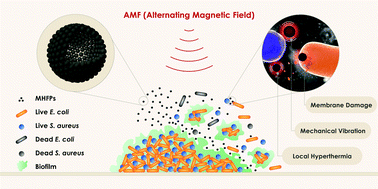The antibacterial and antibiofilm activities of mesoporous hollow Fe3O4 nanoparticles in an alternating magnetic field
Abstract
Unrestricted usage of antibiotics has accelerated the emergence of new strains of microorganisms with antimicrobial resistance (AMR) and the development of therapeutic technologies that do not rely only on antibiotics. Herein, mesoporous hollow Fe3O4 nanoparticles (MHFPs) were synthesized by a one-pot hydrothermal method, and the feasibility and possible mechanism of using alternating magnetic field (AMF) with MHFPs to kill Escherichia coli (E. coli) and Staphylococcus aureus (S. aureus) were explored. The presence of the AMF (2.5 kW, 210 kHz) combined with the MHFPs resulted in a dramatic decrease in colony forming units (CFU) for E. coli and S. aureus in 25 min compared with the pure MHFPs at concentrations of 500, 800 and 1000 μg mL−1. Macroscopic hyperthermia was proved not to be the sole reason for the phenomenon. Visible membrane damage was demonstrated by live/dead staining, scanning electron microscopy (SEM) and transmission electron microscopy (TEM) assays. Besides, the permeability and integrity changes of the cell membrane were then quantitatively confirmed by measuring the relative electrical conductivity. In addition, bacterial biofilms were significantly dispersed in the presence of MHFPs and AMF. These results suggested that under the mediation of AMF, MHFPs can potentially serve as an efficient nonantibiotic therapeutic platform to disperse bacterial biofilms and inactivate bacteria by damaging the cell membrane of the bacteria.



 Please wait while we load your content...
Please wait while we load your content...